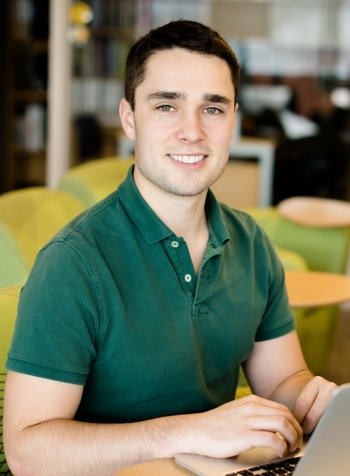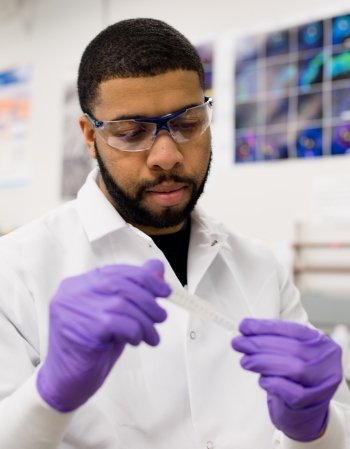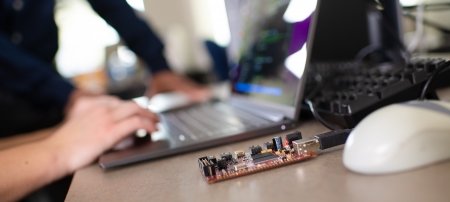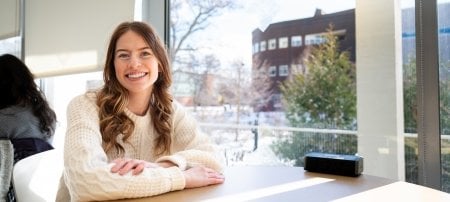Learn more about the Institute of Computing and Cybersystems. Meet a Michigan Tech undergraduate launching his first app, and a graduate student going straight to the heart of health-care research.
Institute of Computing and Cybersystems
Twenty-seven grants, $7.5 million in funding, and 59 supported students, with 51 dedicated faculty members from 12 different schools and departments—impressive numbers for the Institute of Computing and Cybersystems (ICC), which formed just three years ago. Equally impressive are the interdisciplinary collaborations taking place on and off campus.
“We are beginning to see the benefits of our efforts to bring together the many areas of computing at Michigan Tech,” says Min Song, ICC founding director. “It brings faculty and students in sub-disciplines together to discover new knowledge in computing.”
Projects in five specialized centers promote research and learning experiences for the benefit of the University, industry, and the world at large: cyber-physical systems, cybersecurity, data sciences, human-centered computing, and scalable architectures and systems. Machine learning, medical informatics, smart grids, human-robotic interactions, privacy protection— ICC is a computer-research hub where logical match-ups happen. Case in point: researchers who collect data provide it to those who analyze data.
“ICC is the focal point for research in computer-related areas. It fits the Michigan Tech model of research centers that reach across multiple academic boundaries,” says Dave Reed, Vice President for Research.
ICC members develop project proposals and lead research direction. But students—graduate and undergraduate—are also major players, especially in running simulations and experiments. Experience working on National Science Foundation, National Institutes of Health, and Department of Defense-funded projects, for example, can be a career game-changer.
The institute’s goals for the coming year and beyond focus on growing membership and fueling collaborations to take computing research at Michigan Tech to the next level.
Meet researchers, explore projects, and subscribe to get the latest news.
Create the Future
Undergraduate Student

Looma, the nutrition and wellness startup co-founded by computer engineering major Kyle Ludwig, comes to iOS in 2018. The app provides specific, optimized meal plans for busy 18-to-24 year-olds—with a swipe feature some have jokingly referred to as the Tinder of menus. It’s been in the works for three years under different iterations. Ludwig and co-founder Chetan Chaurasiya, a 2017 computer engineering graduate, finessed interface design, ease of use, and conducted independent research. But what truly propelled forward momentum, Ludwig says, is Michigan Tech mentorships and program resources through the Pavlis Honors College, including the National Science Foundation Innovation Corps (I-Corps). The startup was refined through research that centers on designing and developing products around the customer, an oxymoron to the Steve Jobs “I know what users want,” mentality. Processes Ludwig was introduced to in the 2016 Michigan Tech I-Corps Site Program eventually resulted in a name-change (“TRU was always a placeholder”) and the intent of the project (previously focused on personal medical diagnostics).
“The hardest part was getting over ourselves and understanding what users wanted,” says Ludwig, who’s been eating for optimal work performance since he graduated high school. “What product do we make first for the people who want it the most?”
Slated to graduate in May 2018, the Pavlis Honors College New Venture Pathway student transferred here from Traverse City, Michigan, in 2015. “Kyle has done an amazing job developing a network of advisors, mentors, and team members to bring his company through a series of transformations and accomplishments on the path from idea to reality,” says his Pavlis mentor-advisor, Jim Baker, executive director of innovation and industry engagement. Ludwig interned at Ford’s Research and Innovation Center in Palo Alto, California, in summer 2017, where he developed mobile apps and led groups in patent ideation using design-thinking principles gained as a Stanford University Hasso Plattner Institute of Design University Innovation Fellow (UIF) in October 2017. The two-time Accelerate Michigan semi-finalist (2016 and 2017) won the best technology award in the 2016 Michigan Tech’s Bob Mark Elevator Pitch competition. He earned a spot on the annual 14 Floors Silicon Valley Experience that pairs established innovators with up-and-coming entrepreneurs.
Graduate Student

“Any time you put stents inside of arteries there is naturally going to be a reaction,” says Roger Guillory. In his second year of the biomedical engineering PhD program, he continues the research that captivated him in 2013: identifying candidate metals for bioabsorbable stents by looking at the performance and efficacy of degradable materials in live systems.
“I remember the first time I saw it was during a freshman seminar class. I was taken aback by the fact that they were doing all of this at Michigan Tech, fabricating different metals and alloys and testing them in vivo systems,” Guillory says. “The presenter, Jeremy Goldman, put up a couple cross-sections of arteries with wires in them and I was fascinated. I emailed him, and I’ve been working with him ever since.”
In 2016, the Houston, Texas, native received an honorable mention from the National Science Foundation’s Graduate Research Fellowship Program (NSF-GRFP). In 2017, he was one of three Michigan Tech students who earned the highly competitive fellowship.
Biodegradable stents address long-term complications for patients, including restenosis, or renarrowing of the artery. But stents are arterial remodelers; the process can take six months to a year, so the material used won’t degrade quickly. Medicine’s first degradable stents were made of polymers, which weren’t strong enough. Zinc on its own has the same problem, hence the exploration of alloys.
“We work with the Department of Materials Science and Engineering closely. They develop zinc and zinc-based alloy wires, give them to our group in a useable form, and we do biocompatibility testing,” he explains. Wires are implanted in rat aortas; the arteries are later removed for histological analysis of wire, tissue, and tissue-wire interface.
“Being interdisciplinary is so rewarding,” Guillory says. “To have a successful product, you have to work with other people who don’t do what you do. In medicine, you’re going to have to collaborate.”
Michigan Technological University is an R1 public research university founded in 1885 in Houghton, and is home to nearly 7,500 students from more than 60 countries around the world. Consistently ranked among the best universities in the country for return on investment, Michigan's flagship technological university offers more than 185 undergraduate and graduate degree programs in science and technology, engineering, computing, forestry, business, health professions, humanities, mathematics, social sciences, and the arts. The rural campus is situated just miles from Lake Superior in Michigan's Upper Peninsula, offering year-round opportunities for outdoor adventure.




